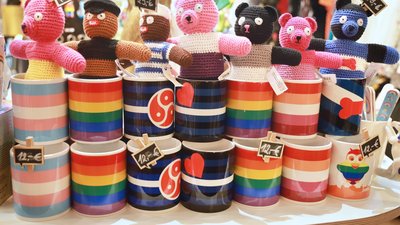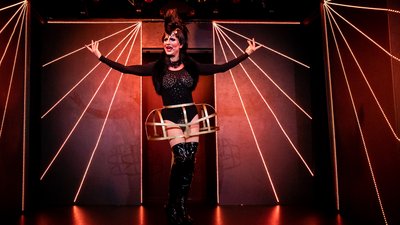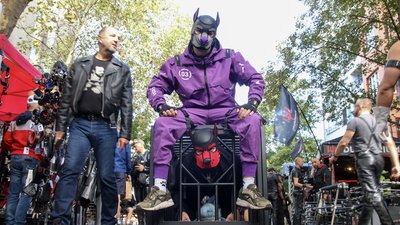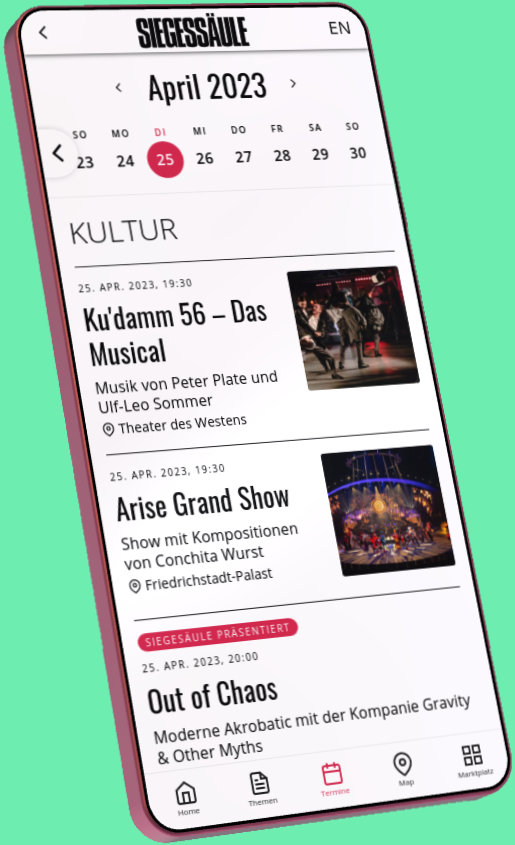Schöneberg was so Lesbian in the Weimar Republic!

The area around Nollendorfplatz in Schöneberg is considered a hotspot of gay subculture. Rainbow flags fly everywhere, laughter and music emanate from numerous bars and pubs, and in the evenings, there are sometimes even queues outside some clubs and shops with darkrooms. However, Schöneberg's queer history is much more diverse. In the Golden Twenties, during the time of the Weimar Republic between 1918 and 1933, Schöneberg was also the most important meeting place for the lesbian community in Berlin. City guide Katja Koblitz shows where and how people celebrated back then and reveals how you can go in search of historical traces.
"While in the past [...] London, and especially Paris, were spoken of as the cities of mysterious pleasures, Berlin has long since surpassed them. [...] Here everyone has the opportunity to be blissfully happy according to his or her own desires; every taste is catered for - even those of the 'so-called outsiders of love', the homosexuals, and among them especially the priestesses of Sappho - they find their sanctuaries where they can escape for a time the narrow confines of bourgeois norms, in order to find happiness in ways that please them".
With these words, Ruth Margarete Roellig describes in her city guide, 'Berlins lesbische Frauen' (Berlin's Lesbian Women) - published in 1928 - the importance of Berlin in the 1920s, especially for women who loved women. Thanks to their own organisations, meeting places, magazines, and events, they became increasingly visible from 1919 onwards, encouraged by the social liberalisation in the first German democracy.
In south-eastern Schöneberg, between the S- and U-Bahn stations Yorckstraße and Bülowstraße, we go in search of their traces. There were thirteen lesbian meeting places here alone - not to mention the numerous homosexual pubs and bars that were used by gays, lesbians and trans people alike. At 53 Bülowstraße, on the corner of Yorckstraße, for example, landlady Cläre ran the lesbian pub 'Oase' ('Oasis'), which was also called 'Mickimaus' (Mickey Mouse) for a time - presumably to capitalise on the enthusiasm that the cartoon character in 'Steamboat Willie' (1928), (the first animated film set to music), had generated in Berlin.
The landlady advertised that 'Mickimaus' "is and remains the cosiest pub of all girlfriends" - by which she meant lesbian women - and that it offered "well-kept beers" at " reasonable price[s]".

We continue down the street towards the U2 elevated railway line and see on the right, at number 57, a residential and commercial complex from the 1970s. Between 1921 and 1933, this was the location of the 'Dorian Gray', whose name alluded to the famous novel by the writer Oscar Wilde, who was convicted of homosexuality in 1895. Richard Bytomski opened it as a dance and event venue, advertising it with its own "new band... decorations worth seeing... and international clientele", thus appealing to a younger audience. As a board member of one of the large homosexual associations of the time, the 'Bund für Menschenrechte' (Association for Human Rights), meetings were also held in the 'Dorian Gray'. After his death in 1927, two friends continued to run the pub, and from 1931, Richard Bytomski's mother, Franziska, ran it together with Anneliese Mater, who in turn was the manager of the nearby 'Olala' at Zietenstraße 24.
From 1928 onwards, the 'Dorian Gray' evolved more and more into a lesbian venue. The lesbian clubs, 'Lamentier' and 'Monbijou des Westens', met there, as did the editorial team of the magazine 'Frauenliebe' and its successor, 'Garçonne'. In addition to "elite evenings for ladies" every Tuesday and Thursday, as well as club meetings at weekends, trans artists such as Ossi Gades from the 'Eldorado' at 15 Motzstraße performed with increasing regularity from 1930 onwards - an indication that the lesbian and trans scenes were closely connected in the 1920s. At the beginning of the National Socialist dictatorship, Franziska Bytomski was still able to sell the pub to Karl Bergmann, the founder of the ladies' club 'Monbijou des Westens', in January 1933, but the 'Dorian Gray', like all homosexual pubs, had to close in March 1933.

To reach our next lesbian hangout, we cross Bülowstraße and turn right at the supermarket. At number 37, in the 1920s, there was the 'Nationalhof', a ballroom in the backyard, which also managed several large dance halls in the era of the Empire. From 1920 onwards, it opened up to homosexual audiences: in addition to performances by 'Theater des Eros', parties such as the 'Böse-Buben-Ball' (Bad Boys' Ball) were held and there were appearances by scene greats, such as the trans artist Mieke. From 1925 to 1927, the 'Bund für Menschenrechte' (Association for Human Rights) used the 'Nationalhof' for club meetings, lectures, and events. Its female members remained on site even longer; other women's clubs were added, which gradually transformed the 'Nationalhof' into a lesbian ballroom. These clubs included 'BiF' and 'Erato', both of which were run by Selli Engler, the editor of 'Blätter idealer Frauenfreundschaften (BiF). Included also were Lotte Hahm's club 'Violetta' and Kati Reinhard's 'Monbijou des Westens' club. The women's clubs hosted dance evenings and costume balls, organised meetings for trans people, put on readings and lectures, and arranged for groups to go bowling and hiking together, in addition to other activities. Especially on weekends, the 'Nationalhof' was very popular and up to 300 lesbians and trans people came together, spread over the three large halls. Admission to the events was free, but in order to attend the dances, tickets had to be purchased, which were cheaper for members than for outsiders.
Presumably in order to secure better advance funding for the balls, the clubs with the largest membership, namely 'Violetta' and 'Monbijou des Westens', merged in September 1929. This led to an outcry of indignation in the lesbian community. This was because the members had not been consulted and, moreover, the 'Monbijou des Westens' belonged to the 'Deutscher Freundschaftsverband' (German Friendship Association) and was transferred to the 'Bund für Menschenrechte' (Association for Human Rights). Part of this club consequently splintered off and met instead in 'Dorian Gray' instead. Lotte Hahm's and Kati Reinhard's clubs remained organisationally separate but each organised balls up to three times a week for 200 women, mainly at the 'Magic Flute' at 62 Kommandantenstraße. As early as autumn 1932, there were no more homosexual events at the 'Nationalhof' and in March 1933, the Berlin ladies' clubs were dissolved. Lotte Hahm nevertheless organised lesbian balls from 1933 to April 1940 by integrating her club 'Violetta' first into the 'Sportclub Sonne', and later into the bowling club 'Die lustigen Neun', and by renting ballrooms in Kreuzberg. Up to 250 lesbians and trans people gathered here on one evening, according to actual police reports. After 1945, she and Kati Reinhard organised balls for lesbians, and homosexual parties were also held again in the 'Nationalhof'. However, the efforts petered out in light of the anti-lesbian climate of the post-war period. The Ballhaus continued life as 'Walterchens Ballhaus' until 1972.
To reach the end of our tour, we cross Bülowstraße via Dennewitzplatz and head to the spot where the elevated U-Bahn railway heads towards Gleisdreieckpark. Here, in the 1920s, stood a house through which the elevated U-Bahn was constructed. In 1923, on the ground level underneath the rail tracks, the 'Hollandais' was opened. As a wine tavern, it not only offered artists concerts and performances by the aforementioned 'Theater des Eros' for a gay and lesbian audience, but people were also invited to dance to its own jazz band from 1926. From autumn 1928, the ‘Hollandais’ organised elaborate costume parties with raffles in the Tiergarten near the 'Instituts für Sexualwissenschaft' (Institute for Sexual Science). These took place in the ballroom ‘In den Zelten 2’, where, among other things, sightseeing flights over Berlin were one of the main attractions. At the end of 1932, the 'Hollandais' was still able to circumvent the ban on dancing in homosexual venues by declaring itself a club, whose membership allowed access to the balls. In March 1933, however, it was forced to close like all homosexual meeting places in Berlin.
After 1945, efforts to continue the pre-war subculture failed. It was not until the 1960s that a few meeting places for gays, lesbians and trans people were able to establish themselves. However, it took until the 1970s before a new women's and lesbian movement were able to build up a similarly lively lesbian subculture as that of the 1920s.

Weitere Informationen
Would you like to go on your own city tour with expert Katja Koblitz? Information is available at the lesbian archive, Lesbenarchiv Spinnboden.
And this is how you get there: The Queer City Pass gives you a ticket for public transport - and on top of that a great discount with lots of partner companies!
Subscribe to Place2be.Berlin's Instagram channel for the latest info and impressions from Berlin!
The Place2be.Berlin city map shows you interesting queer locations all over Berlin.
You can find a complete overview of all events for every single da on the event pages of SIEGESSÄULE, Berlin's famous queer city magazine.












